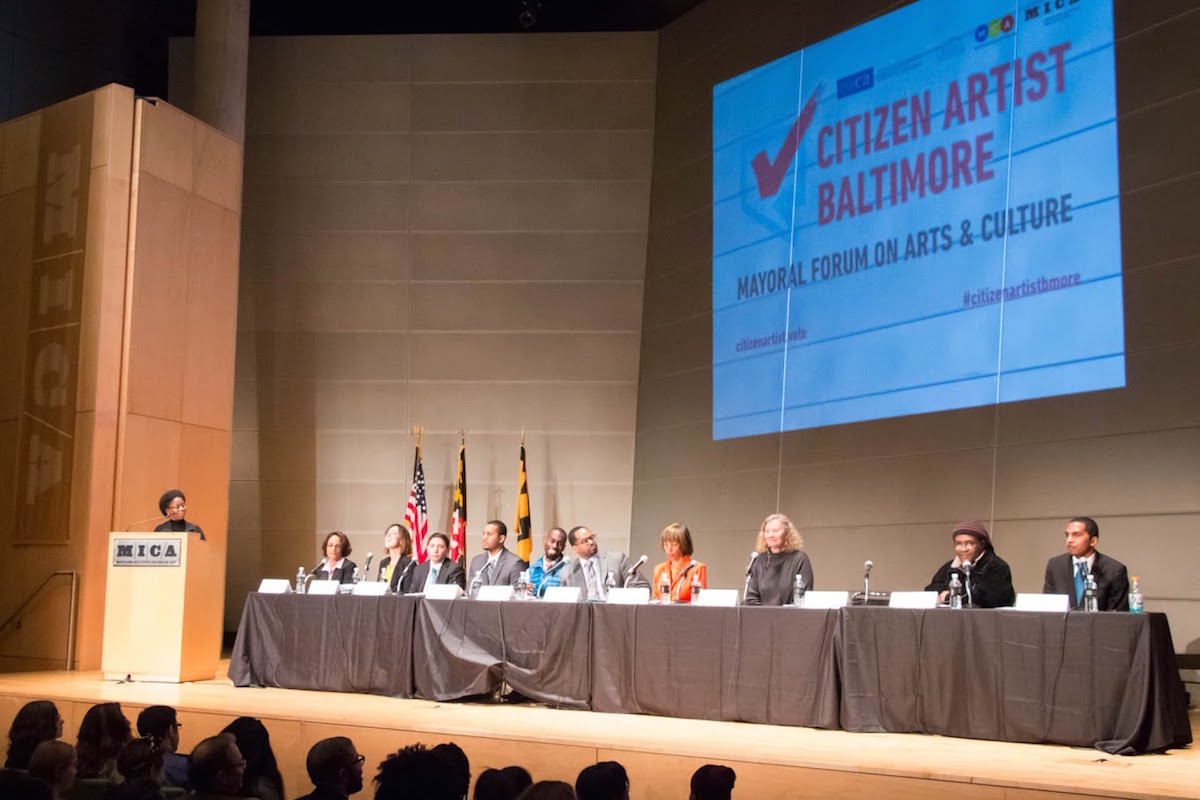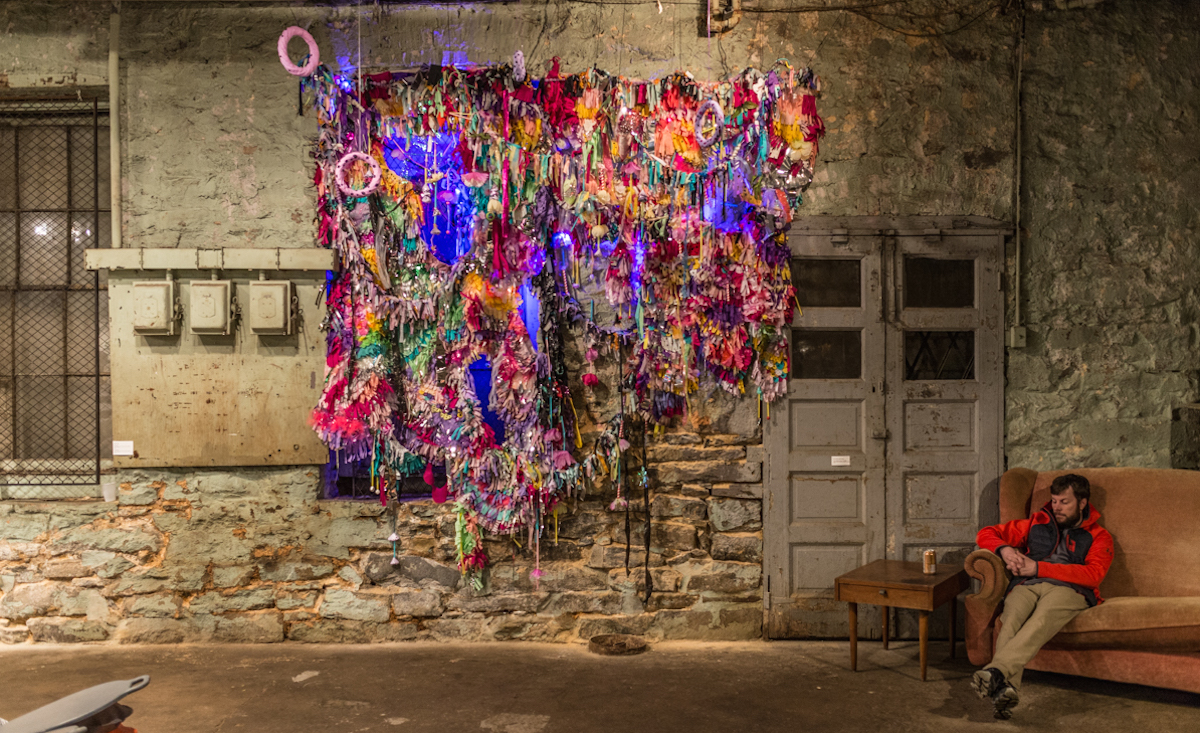Some notes on the Mayoral Forum on Arts and Culture by Bret McCabe
San Diego has its zoo. Milwaukee has beer. And Baltimore, which used to be famous for crabs, now has art. Or at least that’s the message city promoters broadcast last week, as the public relations campaign for this weekend’s Artscape ’82 festival reached its peak.
“What’s the first thing you think of when you think of Bob Hope?” asked local architect Thomas Jewell. “It’s Texaco. Well, when people think of art, we want them to think of Baltimore.”
Mr. Jewell, the executive treasurer of Artscape, sees art as a central element in Baltimore’s new image. “Having an artistic environment helps sell the city,” he said proudly. It encourages “those people with purse strings to loosen them.”
This civic strategy—boost the arts in order to boost Baltimore’s image—has long served as the guiding philosophy for the Mayor’s Committee on Art and Culture (MACAC), an appointed body charged with cultivation and support of various artistic ventures around town, including Artscape.”
— Excerpted from “Artscape; Image building with a ‘clean industry'” by Bill Thomas and Tom Nugent, The Baltimore Sun, June 13, 1982
The final question at the first-ever Mayoral Forum on Arts and Culture was a fill-in-the-blank layup of mutual self-interest. The candidates were asked to complete this sentence: “I ask for your vote as an arts champion because _____________.”
All 10 candidates present—Sheila Dixon, Elizabeth Embry, Patrick Gutierrez, Joshua Harris, DeRay Mckesson, Nick Mosby, Catherine Pugh, Cindy Walsh, Wilton Wilson, and Calvin Young, (David Warnock started out participating in the forum but had to leave for a previous engagement)—had a minute and a half to respond, and their answers reiterated topics that came up throughout the entire 90-minute forum. The arts need to be put back into education and be present in the schools. The arts can change the city and play a role in helping us heal from last year’s uprising. The arts are economic drivers of local economies. The arts need to become more inclusive and equitable. Such statements are the kinds of platitudes expected during a campaign season, and nobody onstage offered any legitimate plan for how any of these ideas become implementable policy. An event with this many participants doesn’t allow for such detailed exploration.
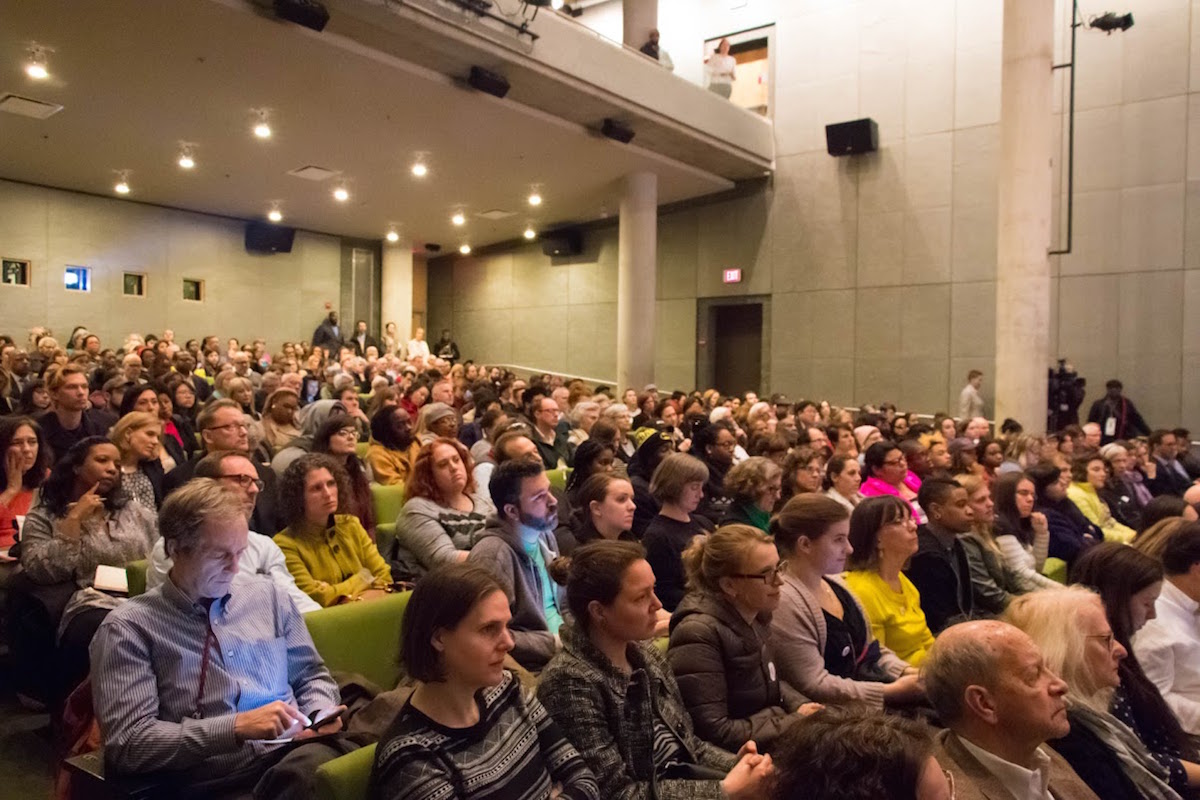
More troubling is the possibility that the voting block self-identifying as the “arts community” doesn’t know what an arts champion in city hall, or local leadership in the public or private sector at all, looks like outside of how the arts have been tethered to the city’s economic development plans.
The forum, which took place March 7 at MICA’s Brown Auditorium, was organized by Citizen Artist Baltimore, an advocacy group, in partnership with the Greater Baltimore Cultural Association, the Maryland Citizens for the Arts, MICA, and the Robert W. Deutsch Foundation (note: the Deutsch Foundation is a financial supporter of BmoreArt). A video archive of the CityExplainer livestream of the event can be found on Youtube. (Note: Gus Sentementes, who started the CityExplainer pilot program, works with me at the Johns Hopkins University, and I disclose that because Hopkins is going to come up again.) Attendees documented various short responses from the candidates via social media, a good number of which can be found by scrolling through the #citizenartistbmore hashtag.
I don’t want to go through what each and every candidate said because so much of it is too superficial to wrestle with on any substantive level (again: 90-second response windows with no follow-up questions makes for thin policy discussion). I do, however, want to mention two ideas that many of the candidates shared, both of which were met with a fair amount of audience enthusiasm, and one idea that is taken as a given when talking about the arts and culture in the city.
The first is the belief/demand that artists and arts education need to be in city schools. I mention it here because it’s the kind of statement about which pretty much everybody can agree. It’s also a subject about which I am embarrassingly underinformed. As somebody who didn’t attend Baltimore city schools and isn’t procreating, I understand very little about how the city, particularly the mayor, influences what does and doesn’t happen in the schools given that the city shares control over the system with the state of Maryland. Organizations such as Arts Education in Maryland Schools Alliance, Arts Every Day, Baltimore Arts Education Coalition, and Young Audiences Maryland are better resources about this intersection of policy and programming.
How arts education turns into jobs for artists is a part of that discussion that needs to be addressed better, and extrapolating slightly from that topic, I wanted to make one modest observation. Though the above organizations primarily focus on pre-college education, it’s worth pointing out that nearly every college and university in the greater Baltimore area—Goucher College, Loyola University, Morgan State University, MICA, Notre Dame of Maryland University, Stevenson University, Towson University, and UMBC—has a fine/visual arts department of some kind. Those local institutions that don’t have full-fledged departments offer some variety of art classes/courses of study. Johns Hopkins has a Center for Visual Arts that offers a minor. Coppin State University has majors in dance and urban arts. And CCBC has art classes, programs, and degree transfer plans.
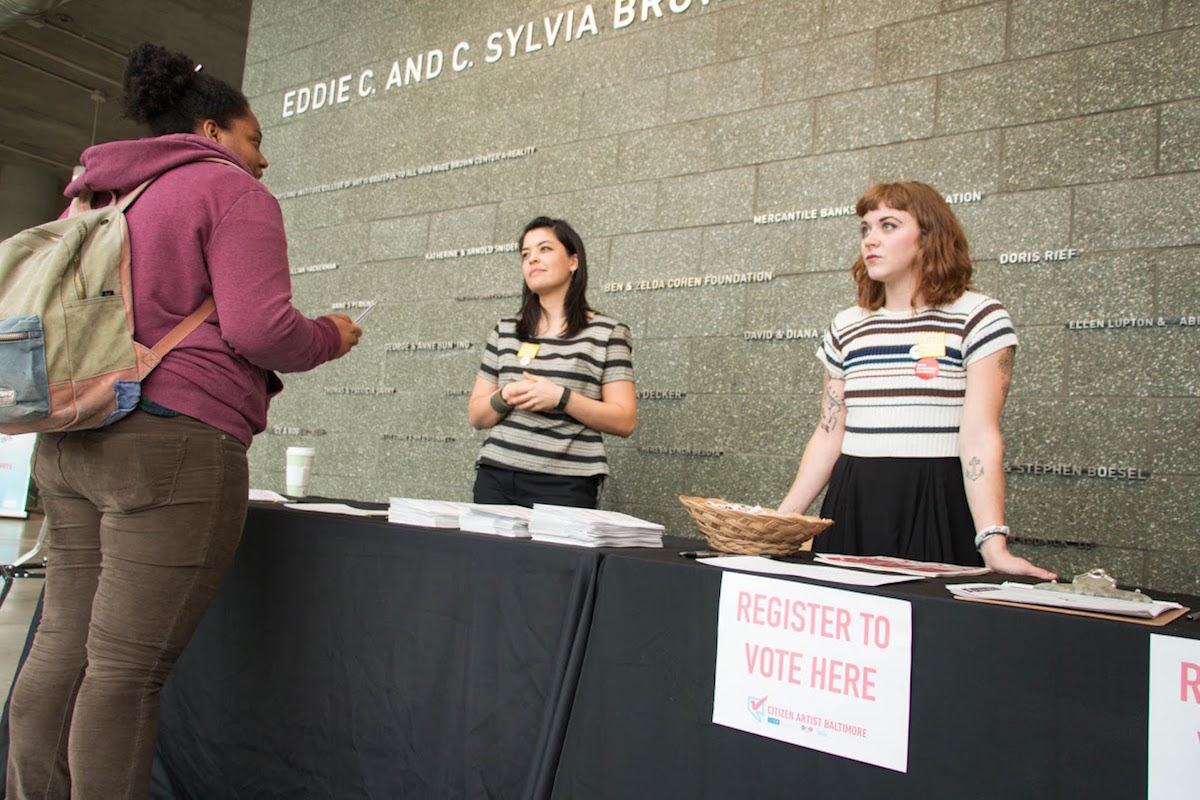
Artists teach these classes, often as adjunct professors, which is higher-education speak for itinerant labor. Many of these colleges/universities also see themselves as anchor institutions in the city’s ongoing revitalization efforts, and members of their leadership teams serve on the boards and executive committees of local nonprofits and arts organizations and the like. Anchor institution development plans/deals sometimes come with tax breaks or public funds or both, and many local universities—like local companies and the state—have some form of local hiring initiatives. I’m shoveling all these things together here because given the large local footprint of institution of higher arts education, I’m wondering if there’s some opportunity to be found for the city to leverage development deals and the creation of more stable full-time teaching positions rather than the roulette of adjunct teaching. This sector of local art workers should be thought about in any arts policy discussion in some way.
The second idea a number of the candidates floated was appointing a cabinet-level person in their administration that would be devoted to the arts. To be honest, I have no idea how such a position plays out. The ostensible “arts czar” is a position a few cities have created—most recently Boston and Kansas City—and in 2009 artists suggested Barack Obama should appoint a Secretary of Culture. Baltimore’s mayor’s office already has the Baltimore Office of Promotion and the Arts, which has an executive director. Do we need another taxpayer-supported, cabinet-level-salaried position in the mayor’s office—even if that person is there to offer arts and culture policy advice?
That’s not snark but a sincere question of how arts policies get framed and made—which brings me to what I feel is the biggest conundrum we face when talking about arts policy in Baltimore. This conversation starts from a place where it’s assumed the only way arts and culture fit into the city is through economic development. Citizen Artist Baltimore highlights that point of view on its website:
“The arts and culture industry in Baltimore generates $388.2 million in total economic activity, supports 9,505 full-time equivalent jobs, generates $260.4 million in household income to local residents, and delivers $33.9 million in local and state government revenue. (Arts and Economic Prosperity IV/Americans for the Arts 2010).”
Those stats are the kinds of data points politicians, developers, and nonprofit leaders mention when talking about the arts as an economic driver of urban revitalization. Now, I’m not about to suggest that this economic impact of the arts doesn’t exist, or that it should be discounted or dismantled in any way. But those numbers reflect a short-term picture.
We’ve been singing this arts-drives-revitalization song for decades now, and I’m not convinced that it’s worked over the long term. In fact, I think the overall conditions of our city’s arts programs, institutions, and artists’ lives in general suggest that it hasn’t worked. And despite that, we don’t consider any other options for even conceptualizing the arts’ relationship to the city. Instead, we go on believing that that arts policies forged by William Donald Schaefer roughly 40 years ago are the only game in town.
That explanation comes from J. Wynn Rousuck, who covered the conference for the Sun; her “What’s ‘behind’ the arts?” article that appeared in the Dec. 18, 1977, edition of the paper. Cwi and Lyall’s paper, titled “Economic Impacts of Arts and Cultural Institutions: A Model for Assessment and a Case Study in Baltimore,” looked at eight local institutions—the Baltimore Museum of Art, the Baltimore Symphony, the Baltimore Opera, the Arena Players, the Maryland Ballet, Center Stage, the Mechanic Theater, and the Walters Art Gallery—and applied a set of 30 equations to determine their “direct and secondary effects on businesses, government, and individuals.” You can find a copy of the paper online.
They found that although these institutions may be economically smaller than other industries in the city, they have a significant impact on the local economy. For the fiscal year 1976, those eight institutions spent $5.3 million on goods and services, 47 percent of that in the city. The researchers estimated these eight institutions provided 1,175 full-time jobs, which produced $9.6 million in personal income—adding that the figures for these eight institutions represent “no more than 10 per cent of the total arts employment in the metropolitan area.”
Lyall added a few arguments that Rousuck quoted, which I’m going to reproduce in full here:
“The availability of artistic and cultural activities can be a decisive factor in both industrial relocation decision and in the recruitment and retention of executives. . . . If arts and cultural activities have an ancillary role in economic development decisions, this would represent an important additional consideration in the development and evaluation of public policy toward the arts.”
These models for measuring the economic impact of the arts, Lyall added, “provide some useful insights to local planners and arts organizations on their contribution to the local economy,” pointing out this such stats can, as Rousuck writes, give “local politicians a reason for something they might already want to do.”
Notice what Cwi and Lyall are suggesting their models represent: an evidence-based, social-science argument for public policy that recognizes the arts as economic factors in urban development. Schaefer had been leaning in that direction since before he became mayor. During the Monday night mayoral forum, candidate and former mayor Sheila Dixon brought up her 2007 proposal requiring publicly funded city construction projects to set aside 1 percent of construction costs for public art, an effort that made mandatory a law that was proposed and passed in 1964 by then-city councilperson Schaefer. By the time Mayor Schaefer spoke to the NEA arts research conference in 1977, he was saying arts and culture was as essential to the city “as schoolbooks,” notes an unbylined Sun article from Dec. 8, 1977. Schaefer addressed the conference prior to the its keynote speaker, then NEA chairman Livingston Biddle, Jr., who used his address to say that the NEA had “earmarked nearly $2 million worth in grants for Baltimore artists in fiscal 1977.”
Remember, in 1977 the NEA had only been around since 1965, and in that short time, Biddle noted, its budget had grown from $2.5 million to $15 million. It is also important to note that a fair amount of Schaefer’s arts and revitalization resources came from federal funds. Not all or even most of it was exclusively from the NEA, but federal funds paid for the renovation construction to convert an old Federal Hill school into the School 33 art center in 1979. Federal funding paid the artists working in the Beautiful Walls for Baltimore mural program. In 1982, the NEA created a free booklet titled Baltimore: The Arts in a Proud City, which, the Sun noted, “explores the avenues taken by Baltimore in supporting artistic endeavors and in using the arts as a reconstruction tool.”
Schaefer singled out both the mural program and School 33 when he spoke to the annual meeting of the American Association of Museums in Washington, D.C., in 1984, where he said (as quoted by Jack Dawson in a The Baltimore Sun article dated June 14, 1984):
“I am absolutely convinced that cultural and economic development are completely interdependent. When business is strong, so are cultural activities, and the reverse is also true. . . . Culture facilities are people magnets that bring vitality to our cities, a vitality that attracts business, tourists, local consumers and others. Our cultural facilities in Baltimore have also tended to stabilize neighborhoods and provide significant impetus to neighborhood revitalization.”
Mayor Schaefer spent more per capita on the arts than any other city in the US. We should aspire to regain that position #CitizenArtistBmore
— Elizabeth Embry (@Embry4Baltimore) March 7, 2016
That spending level is probably easier to do when the federal government has robust support for a wide variety of work and programs, but that hasn’t been the case for some time. That wasn’t even the case during Schaefer’s entire term. When Ronald Regan became president in 1981, his administration cut funding for a variety of programs, including the NEA. Its budget was halved, and his administration wanted to defund it entirely. Part of the economic reasoning behind the cuts was the belief that lower levels of federal spending would stimulate the private sector economy. Arts and culture institutions turned to the corporate world for support.
A 1982 Sun article by Stephen Cera surveyed a number of local culture institutions to determine if that corporate support did, indeed, step up. At the time, it did. The CEO of the Easco Corporation, a hand-tool manufacturer based in Hunt Valley at the time, told Cera that the company has to increase its support for the arts, adding, “As a corporation we’ve concluded we have to find ways to become a larger contributor. That assumes we maintain a high profit position.”
You can probably guess where this is going: The Washington, D.C.-based Danaher Corporation took over Easco in 1991. And over the past three decades, as private businesses wax and wane, their support to local arts institutions stays flat, declines, dries up.
But remember the equivalency Schaefer noted as quoted above: When business is strong, so are cultural activities, and the reverse is also true. If you look around certain parts of Baltimore, business—and the business of development in particular—can appear pretty strong. For fiscal year 2014, Visit Baltimore, the quasi-public organization Schaefer created in 1980 to bring tourists and conventions to the city, estimated the city welcomed 24.5 million visitors, which generated $5.2 billion in spending and supported 82,000 jobs, a 2 percent growth over 2013, as noted by the state of Maryland’s Office of Tourism Development. That’s no small chunk of change, so the city’s businesses that depend on tourism were understandably distressed by the impact the uprising had on its industry last year.
That said, Visit Baltimore had noted incremental tourism growth over the past few years, and yet in recent years the city’s prestige arts institutions—the BMA, the BSO, the Walters—have wrestled with budget issues and financial stability.
I keep returning to these major institutions here because they are the ones for which the city’s current arts polices and funding pipelines are supposedly working as designed: they’re the ones who ostensibly get the lion’s share of funding, they’re the ones with the board members who have strong political and business relationships, they’re the, well, white institutions. And lean is where just about every major arts institution in the city lives as far as is budget is concerned—if they’re even still around. Of the eight cultural institutions Cwi and Lyall studied in 1976, the Baltimore Opera and the Maryland Ballet have closed, and the Mechanic Theater has been erased from the city entirely.
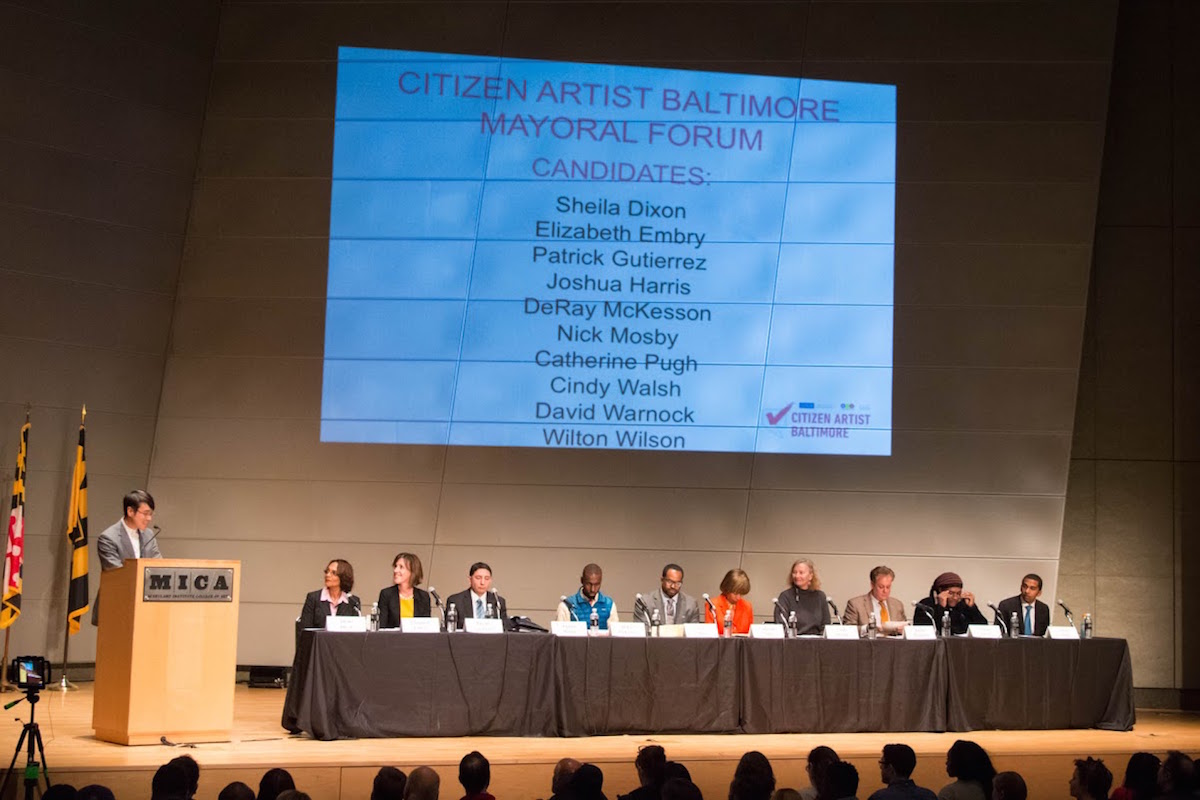
What about the Eubie Blake Center or Jubilee Arts or the Theatre Project or any one of the small, community-based local arts organizations that aren’t major institutions? Nearly all of the candidates at the Mayoral Forum on Arts and Culture brought up equity, inclusion, and access as required goals for the arts in the city, topics at the fore of that intersection of arts and activism in the city for decades, especially in the aftermath of last year’s uprising. How do we achieve that? To listen to the candidates at Monday night’s forum, it’s through transparency—auditing the current financial situation—and putting the right people in to make the right decisions and dispense money in the right ways. It’s not the basic premise of the policies that are flawed; more the people in charge of implementing it.
But when major arts institutions are applying for the same kinds of modest grants and programs and soliciting the same philanthropic organizations as mid-sized and small organizations—which is happening, as many arts organization leaders can attest—something more than faulty leadership is at play. And, yes, one way to look at the situation is to admit that it’s a competitive world out there and the arts have to be better advocates for the work that they do, they have to innovate as entrepreneurs, and do all the things that the contemporary business-speaks says is the path to survivability in the 21st century economy. And that attitude is, for better and worse, as applicable now as it has been for American arts organizations for their entire existences.
Another way to look at that situation, though, is to suggest that harnessing the arts to economic development doesn’t work, that those policies don’t provide sustainable models for the arts—or the arts organizations, audiences, and artists who participate in this economy. And yet, mayoral administration after mayoral administration in this city has proposed some version of Schaefer’s arts-development axis as the basis of their economic development platforms. Schmoke did it in different ways. O’Malley did it (and brought Richard Florida to town to talk about it). Ditto Dixon and Rawlings-Blake.
Now, look, yes—everything above is admittedly reductive, and there are many factors that this narrative isn’t taking into account. This precarious argument was stitched together through one night of archive research and one night of brain vomit writing/editing, spurred largely by the consensus POV, among both the arts people asking questions and the candidates themselves, of this arts-and-economic-development relationship. Again, I’m not trying to suggest that the economic impact of the arts shouldn’t be a concern or priority for city leadership, private businesses, and the arts community. I am, however, suggesting that to see the arts purely through this economic development lens limits the imagination about the other roles of the arts in the city—or even coming out and saying that art is a public right, period.
That insistence could be a subtle but curious wrench to throw into arts policy discussions. One of the annoying side effects of viewing “creatives” as a socioeconomic class is that in addition to understanding creative labor purely in terms of its economic potential, it uses the “arts” to abstract creative labor from issues of gender, race/ethnicity, sexual orientation, and conventional class distinctions. And while, yes, sometimes arts spaces and communities can be more open than other public spaces, but that’s not always the case.
The inequities of the economic and political structures in which artists reside get reproduced in microcosm in arts spaces and communities, and I imagine Baltimore artists and Baltimore citizens care about a number of the same issues this election season: the economic violence of institutional racism, affordable housing (and a subset of that, affordable studio space), stable employment, education, etc. The arts community does have a few issues that are unique to its concerns but still, identifying as an artist doesn’t mean somebody isn’t also another one of the city’s precariously employed, low-income workers juggling adjunct duties, a restaurant/bar gig, dog walking, and freelance design work just to get by. Art prizes awarded by the city and local organizations are prestigious and fun and it’s awesome any time artists get exposure and a check, but it’s not like they come with health insurance.
That’s one of the refreshing things suggested by the three nouns that form Citizen Artist Baltimore’s name: having an impact on the city has to involve being both citizen and artist. One way for artists to do that is going to be at the voting booth, sure. Another is to start being more collectively critical of the city’s arts policies, and perhaps even organizing to set a different arts policy agenda and advocating for it at every opportunity. Because as the Sun story about the 1982 Artscape festival mentions way at the top of this piece, equating Baltimore and art was part of a public relations campaign. And for all of the mere 22 years I’ve spent in this city people—politicians, artists, residents, the media, myself included—have said that Baltimore is a good city for artists. Maybe that’s true. And maybe when you spend your entire Baltimore life in the arts-and-economic-development fishbowl, it’s easy to forget you’re surrounded by that strategy’s water.
Author Author Bret McCabe is a haphazard tweeter, epic-fail blogger, and a Baltimore-based arts and culture writer.
Photos courtesy of Citizen Artist Baltimore and Graham Coreil-Allen.
